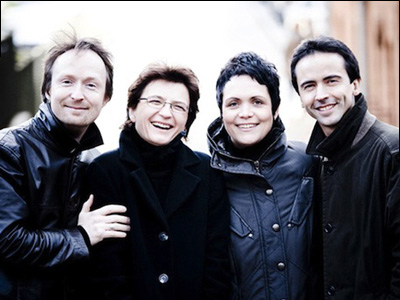
By ANDREW POWELL
Published: January 31, 2014
MUNICH — The 11-year-old Arcanto Quartet, heard here last Friday (Jan. 24), is everything a chamber group shouldn’t be for promotional purposes. There are no family ties. Their instruments don’t match. They share no doctrine about period practice. They don’t grind out whole cycles of anyone’s music. Not surprisingly their U.S. debuts in 2010 passed with only modest fanfare: the Washington Post reviewer found himself split yet intrigued while The New York Times gave no coverage at all. Happily the Arcanto’s record label, Arles-based Harmonia Mundi, favors substance over flack and has documented their work in Mozart, Schubert and Bartók. The latter disc took a Preis der deutschen Schallplattenkritik.
Anchored by Jean-Guihen Queyras’s nimble cello and the resonant viola of Tabea Zimmermann, the group produces a centered, refined, light sound. Three centuries happen to separate the instruments used by these two members: Queyras, longtime soloist at IRCAM in Paris, plays a 1696 Cappa. But this detail seems incidental. Antje Weithaas, artistic leader of the Camerata Bern, and Daniel Sepec, concertmaster for the Deutsche Kammer-Philharmonie Bremen, are the sweet-toned violinists. Twenty-five months ago, here at the Prince Regent Theater, the Arcanto achieved minor miracles in Ravel’s Quartet in F Major before partnering Jörg Widmann for an ardent, haunting traversal of the Brahms Clarinet Quintet. The finicky Bavarian crowd roared its approval.
Last Friday’s visit, with the final quartets (1826) of Beethoven and Schubert, took place in the cool vaulted milieu of the Court Church of All Saints, diligently filled by presenter Bell’Arte. Versatile, nuanced playing proved that each work had been considered on its own terms: the F-Major Beethoven (Opus 135) characterized by nonchalance, the grander G-Major Schubert (D887) by an emphasis on fractionalized ideas that shadow late initiatives of the elder composer.
Beethoven’s Lento assai, cantante e tranquillo ruminated in a contented, consoling way. Queyras launched the lyrical second subject of the Muss es sein? movement with spry point, matched by Zimmermann. As Weithaas danced gleefully over the music’s last measures, after the shared pizzicato, the ensemble built cheerful true resolution not only of the immediate material but of the whole score. The Schubert received an intriguing performance. Ghoulish drama laced its Andante; delicate understated voices emerged lucidly in the Trio. In the passionate sections of the last movement, Allegro assai, the players found power in especially intense collaboration. The same composer’s Quartettsatz of 1820 (D703) served as recital opener, guided with spontaneity and considerable elegance by Weithaas.
Photo © Marco Borggreve
Related posts:
Gloom, Doom from the Arcanto
Festive Sides
Widmann’s Opera Babylon
Volodos the German Romantic
Horn Trios in Church
Tags: Allerheiligen Hofkirche, Antje Weithaas, Arcanto Quartet, Beethoven, Bell’Arte, Camerata Bern, Court Church of All Saints, Daniel Sepec, Deutsche Kammerphilharmonie, Harmonia Mundi, IRCAM, Jean-Guihen Queyras, Jörg Widmann, München, Munich, Preis der deutschen Schallplattenkritik, Review, Schubert, Tabea Zimmermann